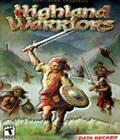Genre: Real-time Strategy
Publisher: Data Becker
Developer: Soft Enterprises
Release Date: 22-Januari-2003
Preview by: Anthony Mitera
When most people think of real-time strategy games they either think of modern/futuristic combat with high-tech weaponry, or way back in time where combat was much more personal with knights and archers dueling it out to protect their empires. Highland Warriors is set in the latter, but now you play the role of either the Scots or the English as Scotland tries to break away from its tyrannical English rule and become a free country. The game sticks mainly to actual historical events but also leaves enough room to make it a game rather than a history lesson. Throughout the course of the game you will lead armies big and small against your foes, with heroes on both sides of the conflict such as the brave Sir William Wallace, the powerful King Edward I, and the great leader Robert the Bruce.
Controlling the game is no different than most other RTS games, which isn’t a bad thing at all. Left clicking with the mouse selects units, and right clicking gives them orders. Peasants can be sent off to build and repair buildings, farm, hunt, mine, and chop down trees for lumber. An interesting system with the peasants however is that they can “master” a certain task if they do it for a good while. If you have a peasant constantly farming, sooner or later that peasant will be eligible to be a master farmer. If you want you can then make that peasant a master farmer, which will make him/her farm extremely well but will also make the skill in every other thing he/she can do go way down. Thus, a master farmer will farm like there’s no tomorrow but will perform horribly if sent off to chop down trees or hunt the various wild animals in the game.
Combat is also similar to other RTS games to some extent. Some units are specialized against others, giving a tactical aspect to the battle. Units can also be set into various modes, such as Hold Ground and Blood Frenzy, which makes them attack and kill any hostile unit that gets anywhere near them. Combat can be anything from involving 10 or so units on each side to 50, really lending to the fact that you are supposed to be commanding an army rather than a small group of troops. Also, some units in the game have special abilities that do various things at a cost of their mana.
One very cool aspect of the game is the camera control. Gone are the days of a fixed top view, which even some of the 3D RTSs of today still seem to hold on to. The camera in Highland Warriors is fully rotate-able and zoom-able, allowing for near total freedom in how you want to view the game. You can zoom in to get a better look at combat or simply to closely watch a peasant build a structure. The rotation aspect is very useful, allowing you to rotate the camera to see behind trees and structures as well as get a better view if something is blocking something else, such as a man on a horse towering above a peasant. This camera engine also lends its hand to the in-game cinematics, which are pulled off extremely well with very artistic shots and camera motions.
Graphically Highland Warriors is fairly sound in both presentation and actual game play. The main menu especially is notable with the menus themselves displayed on a closed castle gate. When you change menus, one gate goes up and another comes down, complete with rotating flywheels and moving chains. Of course, the in-game graphics do not disappoint. The unit models are all done fairly well with good quality textures and models, making them actually look like the Scottish or English. Building models in particular are very nicely done. Some buildings like mills have many moving parts, from the actual windmill to the rolling grindstones in the base. When buildings are attacked parts fly off, fires start, and ultimately the building comes crashing down in a pile of burning wood and smoke. The landscape itself looks very nice, with towering trees, vast mountains, and gentle, rolling terrain. As a whole, the graphics in Highland Warriors do not disappoint.
Sound in the game is pulled off fairly well. While the combat sounds can get a bit repetitive it isn’t immediately noticeable. Peasants building structures pound on bits of wood with their hammers giving off a nice thunk sound, horses neigh and whine as you give them and their riders orders, and the gasps and moans of units who have fallen in battle all lend to give the sound of the game a unique feel. Music in the game is very well done, from the opening song as you reach the main menu to the various songs that are played in the game such as when you are in combat. All of the music fits the time period and locale, with bagpipes and trumpets playing. While there is no support for any advanced sound modes in Highland Warriors, most RTS games don’t have them either. However, that is hardly a negative mark as Highland Warriors performs well overall in terms of both sound effects and music.
As a whole, Highland Warriors delivers a solid RTS experience. Most people will be able to pick it up and enjoy it, since it not only has a great plot but compelling gameplay as well. People who are familiar with the history of Scotland will be able to play through it from either side of the conflict, and people who aren’t will not be hindered by it and just may learn something to boot. With its rich plot, great gameplay, and overall presentation Highland Warriors is definitely a game that should be watched out for.
More articles about Highland Warriors






























